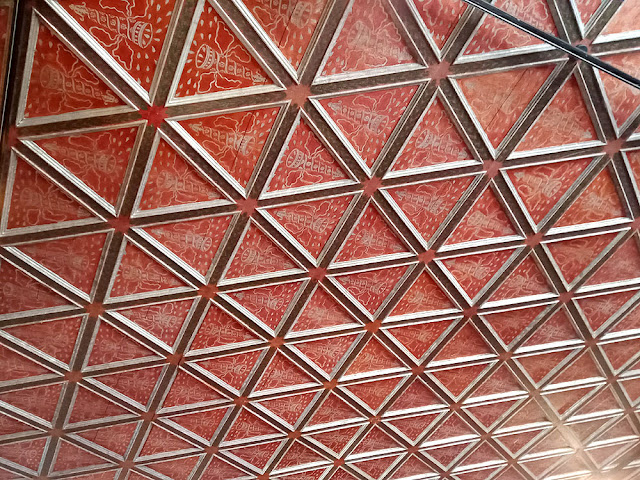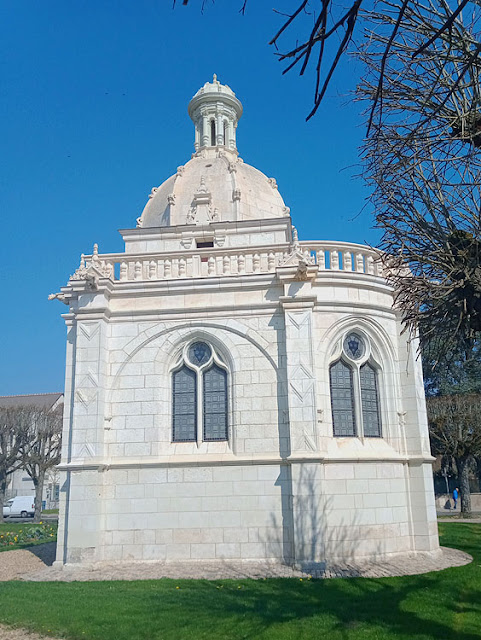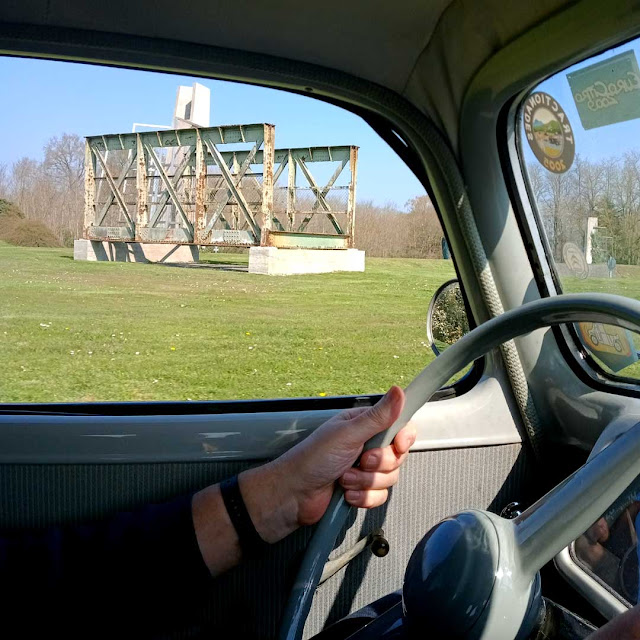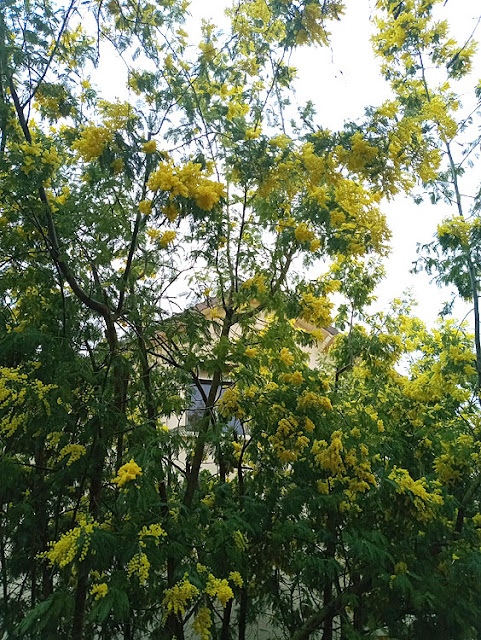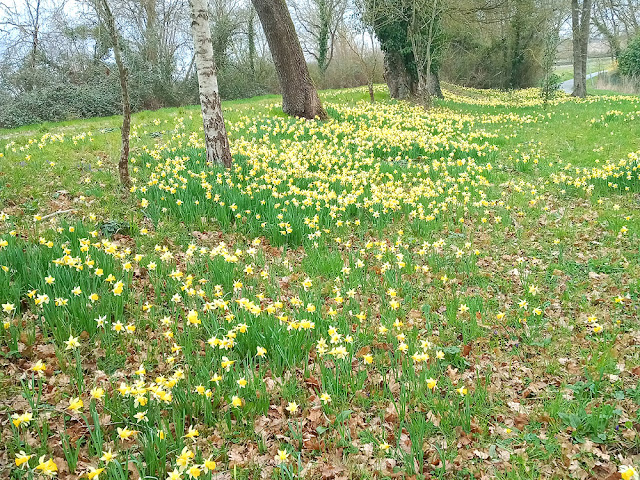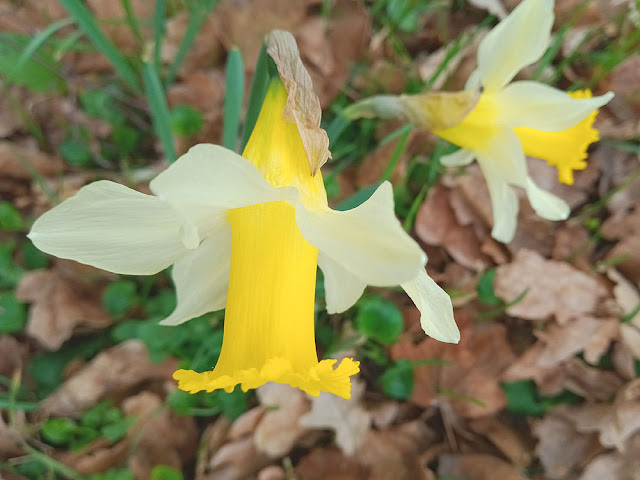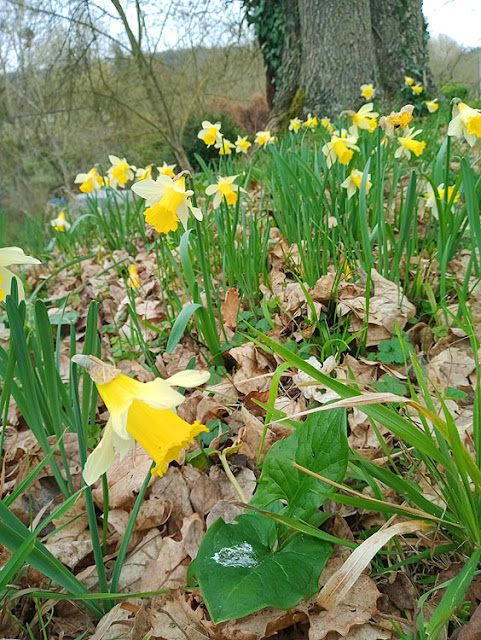The ceilings in every room of the Chateau of Chenonceau are different from one another. The ceiling in the room known these days as the Five Queens Bedroom has a 16th century coffered ceiling (with decorative recessed geometric panels). It was originally in the anteroom to Louise of Lorraine's private apartments, but survived Marguerite Wilson Pelouze's demolition of those rooms. The ceiling panels may have already been removed and put into storage, as the panels from Louise's bedroom had been, or they may have been saved at the time of the destruction of Louise's rooms. Likewise it is not clear when the panels were put up in the Five Queens Bedroom. Decoratively they share motifs with the black and white bedroom panels, which also have weeping cornucopia trumpets as one of the images displaying Louise's sorrow at the loss of her husband Henri III.
Pages
Thursday, 31 March 2022
A Renaissance Ceiling
Wednesday, 30 March 2022
The Restored Chapel of Jehan Seigne at Blere
The Seigné Renaissance funerary chapel at Bléré is the only one of its kind in France. It stands in the public garden that was once the town cemetery and its decorative carvings date it to 1525. The doorway, capitals, holy water basin and keystones are done in a beautiful Renaissance style, with strands of pearls, rosettes, lions' heads, cherubs, and chimeras. There are also references to artillery as testiment to Guillaume Seigné, controller of François I's artillery.
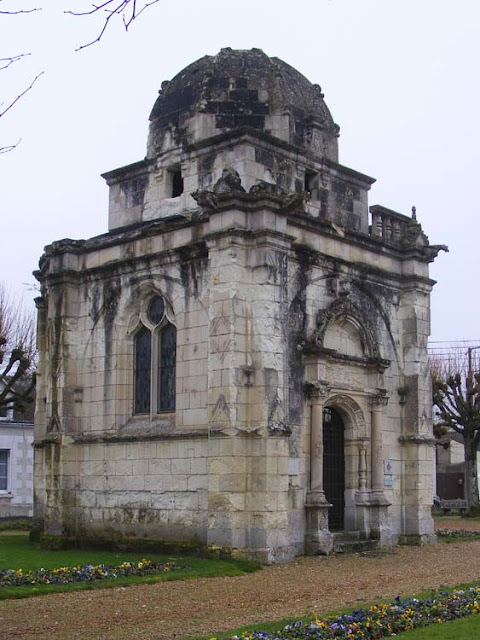 |
| The chapel in March 2016. |
Not renovated for many years, the state of the building was worrying. In 2016 the municipality put in place a plan to restore it, and partnered with a new Friends of the Chapel organisation and the Fondation du Patrimoine.
 |
| The chapel last week. |
The work was delayed because of Covid, but now you can see the chapel in all its glory, with its lantern reinstated and functioning gutters and gargoyles. The lantern has been missing for well over a hundred years.
 |
| Peering through the door. |
Work like this always throws up surprises, and on this site it was that there is a void under the chapel, with an entrance that had been covered over in the last renovation. The archaeologist said that they didn't find anything in the underground space though. This previous renovation was begun just before the outbreak of the First World War and halted because of the War.
The man who was buried here, Guillaume Seigné, Lord of la Lande and Governor of Montrichard, participated in the victorious battle in 1515 at Marignano near Milan with his new King, the 21 year old François I. In 1520 he was responsible for the manufacture and transportation of the tents and pavillions for the famous Field of the Cloth of Gold gathering, where Henry VIII of England and François I met, embraced and proclaimed their enduring friendship, jousted, danced and schmoozed their opposite number's Queen, all with very few long-term results.
The thinking is that Guillaume started the chapel, but it is certain that it was his son Jehan who finished it.
I had forgotten what a sad little building it was before the restoration until I dug the photos from 2016 out of our archive. The restoration has revealed what a gem it really is. Amélie Rob, the conservation sculptor, and the rest of the team who worked on the building and behind the scenes raising the funds to cover the €700 000 cost of the work should be very proud of themselves.
Tuesday, 29 March 2022
There, from here
...and here, from there.
On Thursday evening we visited l'Île de la Métairie, a nature reserve and park on the Loire at the eastern edge of the agglomeration of Tours. I have no doubt Susan will do some research and write about the park soon.
While we were there I took this photo from the Plage de La Ville-aux-Dames (dangerous water, no swimming) of the row of chateaux on the northern bank of the Loire at Rochecorbon. From left to right: Les Hautes Roches (now a hotel), the caves of Marc Brédif (winemaker) with an Italianate looking terrace and troglodyte dwelling above, and the Chateau de Sens on the skyline.
Exactly twenty-four hours later we were visiting the caves of Marc Brédif, so I was able to take a photo of the Parc from their gateway. The photo above was taken from where the people in the photo below are standing.
Monday, 28 March 2022
Roundabout Ornaments.
We wrote back in January about the new bridge across the river Cher at Civray de Touraine. On a recent trip to Chenonceau we noticed that part of the old bridge has been mounted as a roundabout (traffic circle) ornament at the end of the rocade (bypass) around Bleré.
French roundabouts often contain interesting landscaping celebrating the history or industry of the local area, but this is the first time - in my memory - we have seen a bridge as decoration.
Sunday, 27 March 2022
The Coathanger is Ninety
The Sydney Harbour Bridge, nicknamed the Coathanger, is an icon of Australia, spanning the harbour to link the central business district to the North Shore. It is frequently photographed with the nearby Sydney Opera house to create a view that is recognised by almost anyone worldwide. Construction began in 1928 and finished in 1932 and provided a lot of jobs during the Depression.
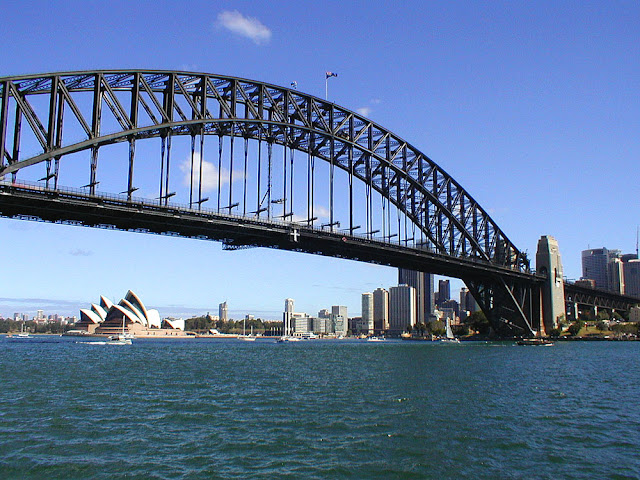 |
| Sydney Harbour Bridge, with the Opera House in the background. |
The final cost of 6.5 million Australian dollars wasn't paid off until 1988. Many of the most well known images of the construction in progress were taken by Henri Mallard, a photographer born in Australia to French parents. He was educated at home and as a consequence spoke strongly accented English. As manager of Kodak in Australia he was able to influence and support the careers of other photographers who also became well known, such as Frank Hurley, who he recommended for the Mawson Antarctic expedition.
Saturday, 26 March 2022
A New Water Meter
Susan wrote on the 11th February about the holes that have been dug in our street. The work commenced early February and was due to finish the 22nd February. Yesterday things started to progress in a forwards motion, and at last we can see what it is they are doing.
Work in Progress: I asked Gilles from the council what the thin pipe (or maybe bundle of wires) is,
and he said he had no idea, but that whatever it is, it's old and of no consequence.
The water arrives in our street in a 25cm (more or less) cast iron (I think) pipe. From there it branched off through a lead pipe to our old meter. Now it does similar, except it branches off through a reinforced rubber coated pipe into a shiny new meter.
Our shiny new meter. You can see our neighbour's cruddy old meter to the left of it.
The only thing that has really suffered is that the garbage truck can't get to us, so we have to take our bags to the bottom of the street.
Friday, 25 March 2022
Walking From La Celle Guenand
On Monday 21 March we joined a walk from La Celle Guenand, but only just! Due to a confusing email we thought the start time was 2:30 pm, but it was actually 2 pm. We drove into La Celle Guenand to see the walking group already well on their way, on the other side of the stream. We parked and thought we could catch them up. Just as we were about to head off at a pace, more people turned up, also under the impression that the walk started at 2:30 pm. Things started to get chaotic and confusing. I got a lift to where I had last seen the walkers and ran to catch them up. By this time Simon had simply disappeared and wasn't answering his phone. The friends who gave me a lift decided they weren't into running and just went home. The walkers milled around for a bit, then we decided to continue. We couldn't do much if we couldn't contact Simon. By this time the walkers were on the far side of the sports ground. I tried Simon again, and this time he answered, so I told him where we were and he drove up to catch us. Which meant that at the end of the walk we had to walk from the centre of the village to the sports ground to get the car. But it was only a 5 km walk in total so not a problem. Simon had walked a couple of kilometres more in his efforts to catch the group initially, and we cannot understand how he missed the walkers as they entered the sports ground.
 |
| The walkers approaching the Moulin de Civray. |
 |
| The rare Purple Toothwort Lathraea clandestina (Fr. lathrée clandestine) growing at the base of the poplar trees along the mill stream. You can see why this parasitic plant is called toothwort. |
 |
| The Moulin de Civray still has its water wheel in place. Rather unusually it is an overshot wheel. |
 |
| A drystone wall constructed of flint with some old cauldrons inserted for a new life as planters. |
 |
| Old farmhouse. |
 |
| Installing fibre optic cables. |
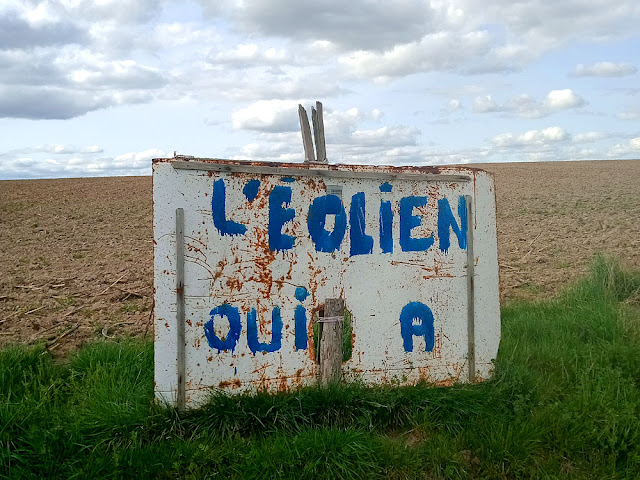 |
| A sign that has presumably been erected by a pro-wind turbine farmer. It caused a certain amount of chuntering amongst my mostly nimby friends. |
 |
| Isolated pear trees on field edges like this are a common feature of the Touraine Val de Loire countryside. |
 |
| Oxlip Primula elatior (Fr. Primevère élevée), much rarer than its cousins the Primrose and the Cowslip. |
 |
| A pollarded tree in a front garden in La Celle Guenand. |
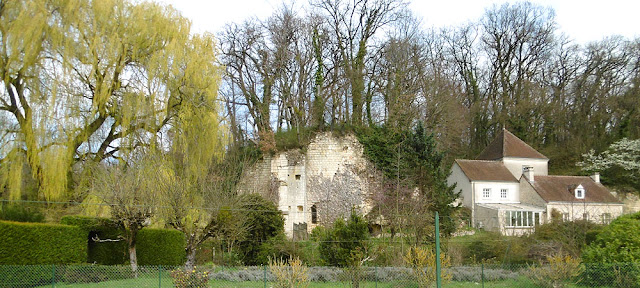 |
| The ruins of the Manoir de la Celle Draon. |
Thursday, 24 March 2022
The end of the day
Last Thursday we were in Tours. Susan was at a tourism conference, and I was replacing Claudette's steering wheel.
After I picked Susan up from the conference we had a quiet drink with our friend Laetitia in Vouvray before driving home. Because of the Saharan dust, our sunsets have been quite amazing: Susan managed to take this photo from the passenger seat of our car as we were driving along the levee of the Loire River.
Tuesday, 22 March 2022
Walking From Chaumussay
On Thursday 10 March we walked a 10 kilometre loop from Chaumussay.
 |
| The back of the church in Chaumussay. |
 |
| A garden shed in Chaumussay. |
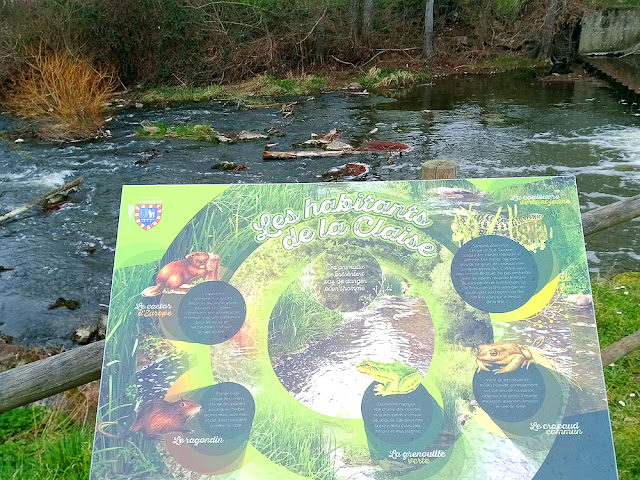 |
| A board to inform the public what lives in the Claise River -- grass snakes, toads, green frogs, coypus and beavers. |
 |
| Lesser Periwinkle Vinca minor (Fr. Petite pervenche) is native to the Touraine Val de Loire. |
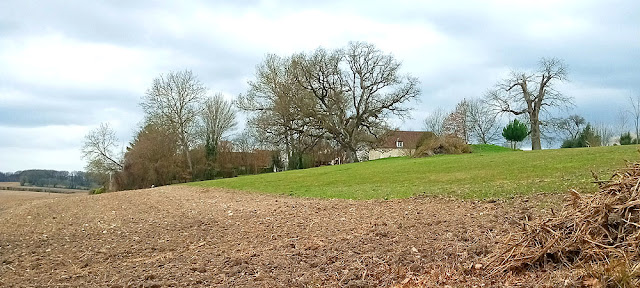 |
| Les Frippières, a hamlet of half a dozen houses. |
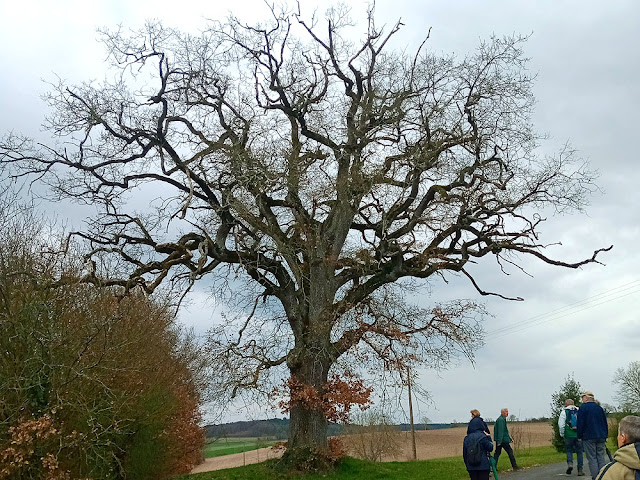 |
| A lovely oak tree (Fr. chêne). |
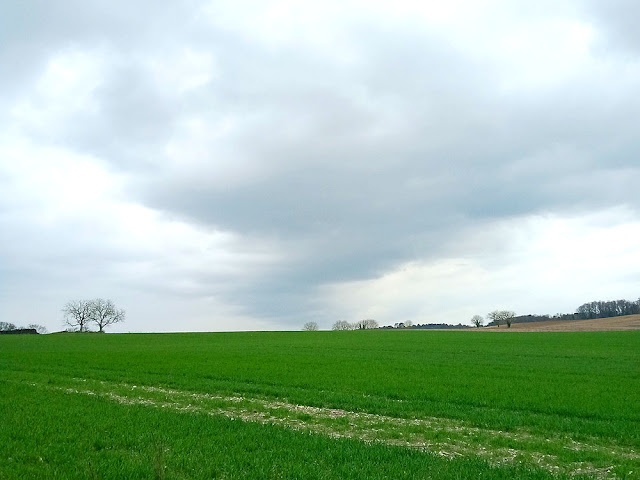 |
| A typical Touraine Val de Loire landscape. |
 |
| Blackthorn Prunus spinosa (Fr. Prunellier sauvage). |
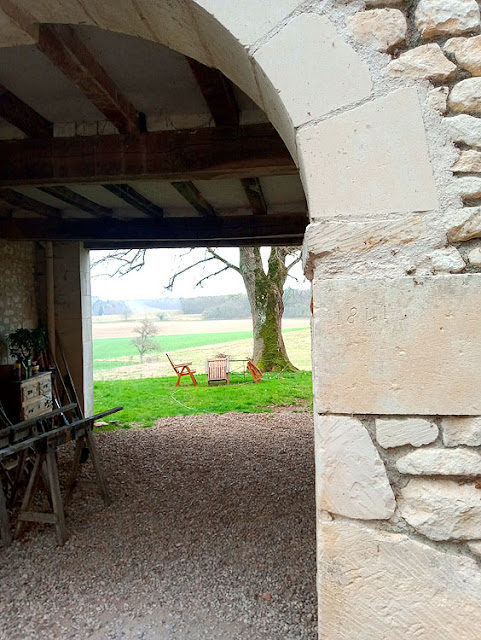 |
| This farmhouse has a rather good view. |
 |
| The same farmhouse. |
 |
| Long-leafed Lungwort Pulmonaria longifolia (Fr. Pulmonaire à longues feuilles). |
Monday, 21 March 2022
Sustainable French Lamb
Agneau de Poitou-Charentes (Poitou-Charentes lamb) is an IGP (Indication Géographique Protégée or Protected Geographical Designation) certification label for quality lamb produced in Poitou-Charentes, and covers a quarter of total lamb production in France. Agneaux des Bocages is a sub-group of this IGP, and concerns extensively raised lamb on the traditional pasture system known as bocage. The sheep graze in small fields surrounded by hedges and it is a sustainable way to raise livestock and benefit biodiversity. It is not just the meat which is certified, but the fleece and hide as well.
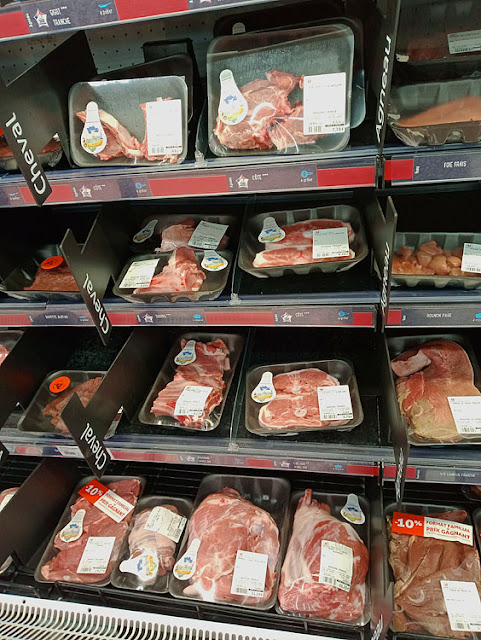 |
| Bocage lamb at our local supermarket on Friday (and yes, that is the horsemeat section to the left). The lamb is priced at between €17/kg and €27/kg, depending on cut. |
Lamb produced in the départements ('counties') of Charente, Charente-Maritime, Deux-Sevrès and Vienne can have this certification. We live in Indre et Loire but 10 minutes from the border with Vienne, and the supermarket I shop at is in Vienne, so every year I look out for the Agneaux des Bocages, because it's sustainable, affordable and local. Like many other products in France it is seasonal, not available all year round.
 |
| Sheep and wild Lady Orchids Orchis purpurea (Fr. Orchis pourpre) share the bocage. |
Despite its importance as habitat, bocage is not protected per se, and is disappearing. The principal areas still using this type of pasture system are a band north-east of Angouleme and south-east of Poitiers, around Montmorillon and to the south; and between Niort and Poitiers, around Saint Maixent l'Ecole, Parthenay and Bressuire, to the Atlantic coast.
 |
| Sadly, this is what bocage often gets turned into now. Most farms have switched from grazing animals to growing crops (wheat, grapes), and in this case, poplar trees. |
Sheep have been an important part of the agricultural sector in Poitou-Charentes since medieval times. Initially they were primarily grown for their wool, but these days it is the meat that there is a market for. By the 19th century, the plains north of the Loire in the Paris Basin had abandoned their mixed sheep and cereal production and concentrated solely on grain production. In contrast, the land south of the Loire and to the west, which was more difficult to plough and couldn't be converted to intensive farming techniques, primarily grazed sheep. But from the 1960s the land around Poitiers to the south and west was being ploughed up to grow wheat, maize and canola, and a third of the hedges grubbed up. The area of land in Poitou-Charentes that has never been ploughed has more than halved since 1960, and a quarter of the ponds have disappeared. Bocage is rather damp and lush habitat, one reason why it is so important, and why the change to intensively farmed cereal 'deserts' is so undesirable from an ecological point of view.
 |
| Aubrac cattle in a well managed traditional bocage field. |
I always like to support the small group of sheep farmers who are dedicated to maintaining the bocage and if I'm not buying lamb produced within a few kilometres of my house, I will buy the next best thing, from a bit further away, but still local and sustainable.
Sunday, 20 March 2022
An Abundance of Acacia
On the eve of International Womens Rights Day my friend André emailed with a series of photos of his gorgeous Silver Wattle Acacia dealbata (mimosa to him) flowering away like crazy. His note said to come over and fetch some whenever you like. So I did.
He knew 'mimosa' was Australian, and that Nicolas Baudin's expedition had brought it back for the Jardin des Plantes (the national botanical gardens in the middle of Paris), and perhaps more significantly, for the Empress Josephine to plant at Malmaison. It thrived there and she sent plants to the south of France where it has now unfortunately naturalised and become an invasive alien species.
Mimosa is beloved in France because of the time it flowers, in early March, and even earlier in the south. In March most European trees don't have their new leaves, and most haven't flowered yet.
What he didn't know though was the charming tradition of men giving women mimosa on International Women's Day in European countries from Russia to Italy. I think the idea is that you get a sprig like a button hole, but André got a bit carried away. I came home with a car boot full of mimosa (I'm not kidding!). It was so much that I couldn't find enough space for it in the house and so I gave some of it away to various friends.
André's Silver Wattle is thriving, and he says it gets better every year. It looks like it has been pollarded or suckers readily as it is really a thicket of wattle by one end of his house. None of the stems are very thick.
Saturday, 19 March 2022
A Clamecy Street Scene
Last October we were in Clamecy (Burgundy), where we took this photo. Looking at it yesterday, it occurred to me that it probably looked like this at any time over the last 200 years.
Friday, 18 March 2022
Wheely Good
Claudette's steering wheel has always been sub-optimal. The original steering wheels on Traction Avants are bakelite, which is prone to cracking. Celestine's wheel had lost its shiny outer layer, which we had repaired two years ago (I know that for sure, it was the day before lockdown started), but Claudette's wheel needed more than a light sanding and a new coat of paint.
A couple of weeks age I received a marketing email from one of the car part companies we have used for Traction Avant parts, and they had new grey steering wheels on sale. The company is based in the Netherlands, and knowing that Huub was about to visit I asked him to pick up a wheel, which he duly delivered earlier this week.
Yesterday I went up to Saint Pierre des Corps and visited Claudette in our garage up there, and changed the wheel. I was slightly nervous about the process because I could find no instructions online on how to do so.
It turns out that the reason there are no instructions is because it is ludicrously simple. Three bolts and a little bit of gentle (and I'm not being euphamistic here) persuasion, and the job was done within 10 minutes.
Thursday, 17 March 2022
A Wordsworth Moment
I wandered lonely as a cloud
That floats on high o'er vales and hills,
When all at once I saw a crowd,
A host, of golden daffodils;
Beside the lake, beneath the trees,
Fluttering and dancing in the breeze.
Continuous as the stars that shine
And twinkle on the milky way,
They stretched in never-ending line
Along the margin of a bay:
Ten thousand saw I at a glance,
Tossing their heads in sprightly dance.
The waves beside them danced; but they
Out-did the sparkling waves in glee:
A poet could not but be gay,
In such a jocund company:
I gazed--and gazed--but little thought
What wealth the show to me had brought:
For oft, when on my couch I lie
In vacant or in pensive mood,
They flash upon that inward eye
Which is the bliss of solitude;
And then my heart with pleasure fills,
And dances with the daffodils.
Wordsworth isn't my favourite poet, but if you've just seen an extensive colony of truly wild daffodils that you didn't know existed, then he's the obvious thought.
We came across them on our Thursday 10 March walk from Chaumussay. I've obviously never passed this way at just the right moment to see them in the last decade. They are rampaging across the former railway embankment just outside the village and on what is now the Greenway (Fr. voie verte).
Wild Daffodil Narcissus pseudonarcissus (Fr. Narcisse jaune) is the most abundant Narcissus species in Europe, with dozens of vernacular names depending on region. The quite large flowers can be identified because the trumpet is a much brighter yellow than the creamy tepals. The Narcisse jaune is often erroneously called a jonquille, but strictly speaking, this vernacular name refers to another species, native to the Mediterranean.
It is a plant that in some places is rather rare, but in others forms dense carpets of flowers in open meadows, especially warm west facing slopes.

